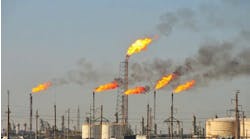Phillip Mngadi
[email protected]
A: The short answer is yes, it can, but the subject deserves a more detailed answer: The Controlotron 1010P ultrasonic flowmeter is a portable, clamp-on sensor that is mounted on the outside of the pipe. Being clamp-on, it requires good acoustic coupling to the pipe to make sure that the coupling does not fail due to thermal expansion of the pipe or the drying out of the coupling material, nor will "ringing around the pipe" occur.
Because these flowmeters operate by averaging the velocity profile of the flowing fluid, the meter factor varies with the Reynolds number, so they can be used in the turbulent region (RE >> 10,000) or in the laminar region (RE < 4000), but not in the transition zone between them.
The Controlotron 1010P is better than the older clamp-on designs, because it uses "wide beam" technology, which injects the sonic wave into the pipe wall at its resonant frequency, exciting the pipe wall itself, so it becomes the transmitting device. It also can operate in either the transit time (more accurate) or the Doppler mode (less accurate), so if the pulp consistency is too high for the transmission mode, you can switch to Doppler.
The main limitation is accuracy, which is better with the dual-channel transit design than with the single-channel ones, but still is low. You did not give the flow range or velocity range you need to work with, nor did you indicate if you have 20 diameters of straight upstream pipe run, which is needed for the velocity profile to fully develop, so I am only guessing on accuracy.
I would say that you can go ahead using the 1010P if you can live with an accuracy of 5% AR in the transmission or 10% AR in the Doppler mode.
Béla Lipták
[email protected]
A: Ultrasonic transit time flowmeters such as the Controlotron model mentioned are designed for homogenous liquids and some gases. The use of transit time ultrasonics in pulp flow with low density or consistency is possible, but the problem with ultrasonic flowmeters is that the speed of sound in a fluid is dependent on the density of the fluid. If the density (or pulp consistency) changes, so does the speed of sound, and this affects the measurement directly. Also, the higher the solids content, the more likely the sonic beam is to be attenuated to the point of uselessness.
For permanent installations I recommend using magnetic flowmeters for this application wherever possible.
Walt Boyes
[email protected]
A: The chances are it will work because the product is a combination of both time of flight (only works on clear homogeneous fluids, such as water) and Doppler (requires particulates or air bubbles in the process to operate). Some products claim to operate on clean fluids, provided there are eddies or flow perturbations in the process fluids that act like particulates, i.e., Reynolds number > 10,000.
Now your process, 1.5% consistency pulp stock (in water? in a CTMP mill?) is going to be a lot like water. A trial of the 1010P might be best in this case.
Peter Baker – CAP, CTech
[email protected]
Q: When I look at vendors' literature, the accuracy is often given as a percentage without stating of what (of full scale? of actual reading? over what range?). The sales literature also often gives the accuracy of only the flow element, and does not include the error contributions of the loop components (transmitters, etc.) Do you know of a user-generated source of such information?
Harry J. Crowney
[email protected]
A: All the flowmeter accuracy data in the four editions of my handbooks was based on user feedback and independent testing sources, not on manufacturers’ self-evaluation, and has always stated if the data is in %FS or %AR, and if it’s given only for the sensor or the whole loop. I know that the flow chapter is 253 pages, and the search takes some time, so here is a summary.
Béla Lipták
[email protected]




